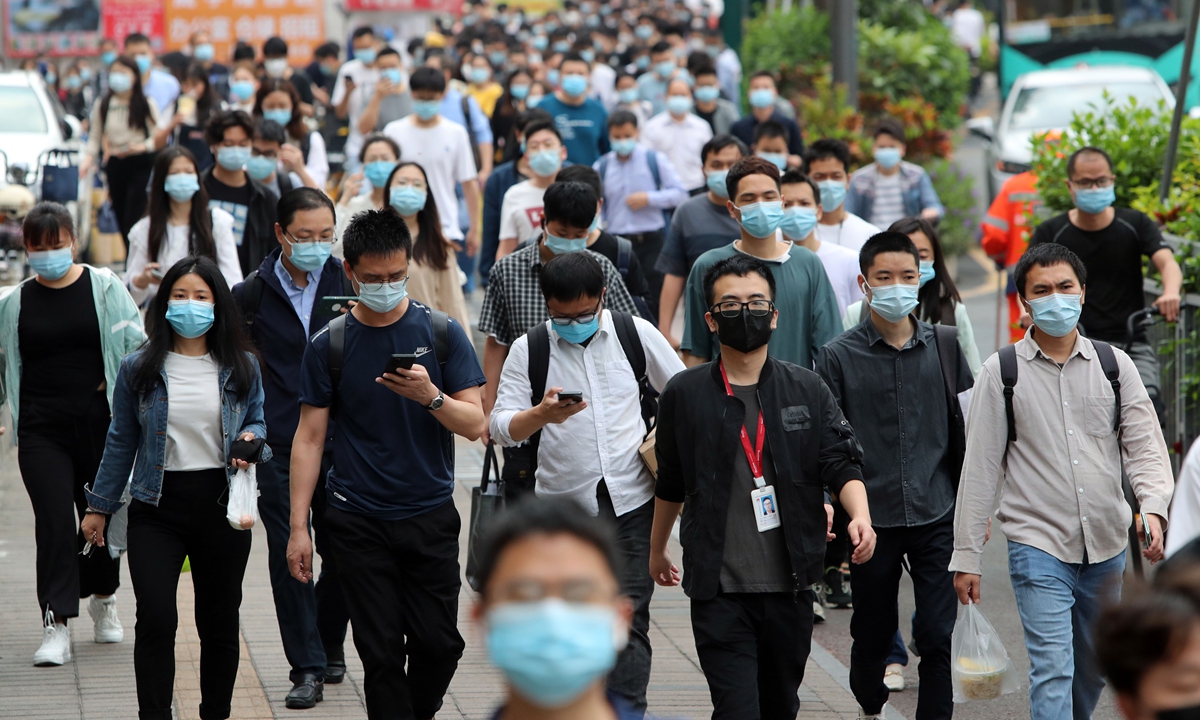
People walk into a hi-tech park in Shenzhen on March 21, 2022, the day when the city resumed production, business and public transport after a week of restrictive measures to quickly curb the COVID-19 resurgence. Photo: Xinhua
Shenzhen in South China's Guangdong Province, a city of 13 million and China's silicon valley, reopened high schools and cultural venues, and launched a series of construction programs on Friday, after achieving zero-COVID cases at the community level.
Shenzhen, a metropolis struck by an Omicron outbreak since February, decided to "pause" from March 14-20, requiring businesses and firms not related to basic livelihood to suspend operations or work from home, at a time when 400 cases were reported in a month.
The decisive measures at an early stage ensured the city could control the contagion quickly, allowing production and public transport to be partly restored as early as March 21. The resumption of schools on Friday was seen as marking an overall recovery from the outbreak, setting the city as a model in the latest round against Omicron outbreaks in multiple localities.
Friday also marks the 2nd anniversary of Wuhan's lifting of a lockdown from the country's initial COVID-19 outbreak. Shenzhen was seen as another city that stamped out an epidemic with courage and public solidarity.
According to education authorities, 10th and 11th graders were the earliest to return to school on Friday, while graduating students of middle and high schools, namely ninth and 12th graders, will resume in-person classes on Monday. Different districts will decide their return to school for other grades in accordance with their conditions.
Shenzhen reopened cultural venues, including museums, libraries and art galleries on Wednesday, setting a cap for visitors and asking residents to present a negative nucleic acid test result within 72 hours to enter. Movie theaters also reopened with an occupancy cap.
Shenzhen also resumed the sea route between its Shekou port and Jiuzhou port in neighboring Zhuhai city. Maritime travel from Shekou to Zhuhai's Wailingding, Dong'ao and Guishan islands will resume on Saturday.
The city on Friday launched 200 projects for the second quarter. The projects, with a total investment of 162.44 billion yuan ($25.50 billion), include infrastructure, social livelihood and housing. Officials said at a launch ceremony that they will provide strong support for the high-quality economic and social development of Shenzhen.
Kong Lan, a manager's secretary of a company exporting scopes in Shenzhen, told the Global Times on Friday that her company suspended business in the "pause week," when they could not receive goods from factories in Shenzhen, Wuhan in Central China's Hubei Province and Nantong in East China's Jiangsu Province. Outbound deliveries to European countries and North America were blocked for about two weeks.
"If there was no lockdown, our business would have run as normal, but there would have been a higher risk of infections which will increase our cost of epidemic prevention and could impact the business for a longer period," Kong said.
Shu Ning, a Shenzhen resident, told the Global Times that she questioned whether it was necessary to take such strict measures when there were hundreds of cases, but later realized a decisive "pause" can guarantee the quickest restart for a city like Shenzhen.
If the city did not suspend public transport and non-essential industries, commuters could contract and spread the virus, causing severe consequences beyond the city's capability to handle, Shu said.
Shenzhen's most important experience in this round of outbreak was to firmly stick to a dynamic zero-COVID policy at the early stage. The slow life made for a rapid resumption, Lu Hongzhou, the leader of Shenzhen's anti-epidemic expert team and head of the Third People's Hospital of Shenzhen, told the Global Times.
Chinese leaders stressed achieving the maximum effect in prevention and control with minimum costs, and to reduce the epidemic's impact on socioeconomic development as much as possible, at a Party leadership meeting on March 17 in the midst of domestic outbreaks.
Shenzhen set an example of maximum results at minimum costs, and reined in the epidemic to avoid any long-term impact on socioeconomic development, experts said.
The city also established the country's first pet care center for owners under COVID-19 quarantine, after reports of rough treatment of infected residents' pets prompted nationwide concerns — another example of how the city has explored a balance between epidemic control and people's daily lives.




